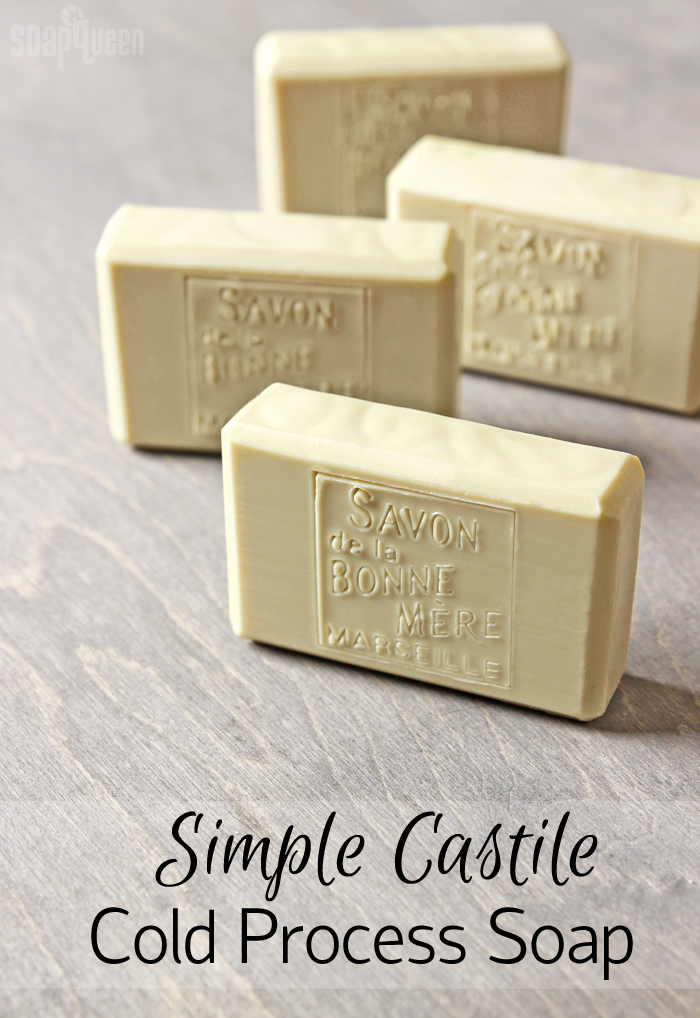
Cold process soap made with 100% olive oil is known as “Castile” soap. It is thought to originate in the Castile region of Spain – thus the name, Castile soap! Olive oil is a staple soaping oil that can be found in many cold process recipes. Olive oil contributes moisturizing properties to soap. It also gives the bars a gentle and creamy (read: small, lotion-like) lather, making it a great choice for dry or sensitive skin.
When you create soap with only olive oil (Castile soap), the batter takes quite a while to come to trace. Castile soap also takes longer to harden in the mold than most cold process recipes that contain hard oils like palm or coconut. In fact, Castile soap can require up to two weeks in the mold before it can be removed! But, there are a few tricks to help Castile soap harden more quickly. This recipe has a 20% water discount, which helps the soap harden much faster. To learn more about how and when to water discount recipes, click here.
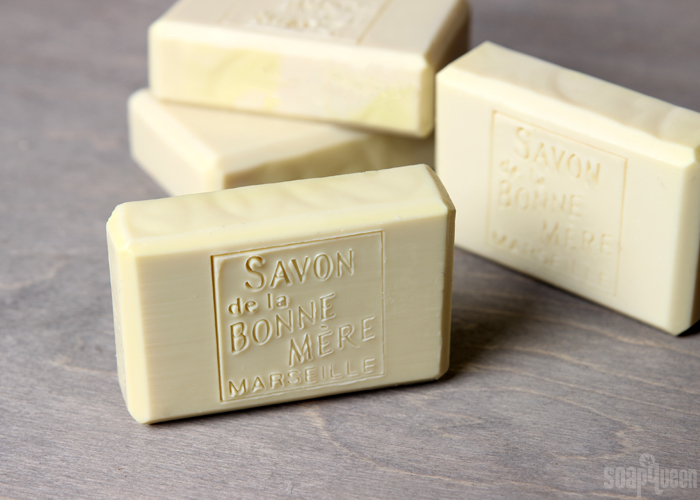
Another trick for hardening Castile soap more quickly is sodium lactate. Sodium lactate is the sodium salt of lactic acid. It’s commonly used as a food preservative, and is also used in lotion recipes for its humectant properties. When added to lye water, sodium lactate helps cold process soap harden faster. I use it in almost all my cold process batches, especially when using a silicone mold. The usage rate is 1 teaspoon sodium lactate per pound of oils in the recipe. It’s an optional step but I highly recommend it, especially for this recipe! Learn more about sodium lactate here.
The final trick to helping this soap harden in the mold faster is gel phase. ‘Gelling’ and ‘gel phasing’ in cold process soap refers to a part of the saponification (soapmaking) process where the soap gets warm and gelatinous – up to 180 degrees. Heat speeds up the saponification process. Hot process soap, for example, can be cut usually within one day, and can be used right away. Soaping on the warmer side (about 130 ° F) and insulating the soap for 24 hours helps promote gel phase. If your room is cold, you may want to place the soap on a heating pad to keep it warm. Learn more about gel phase here. With a 20% water discount, sodium lactate and gelling, I was able to unmold and cut this soap in 2 days.
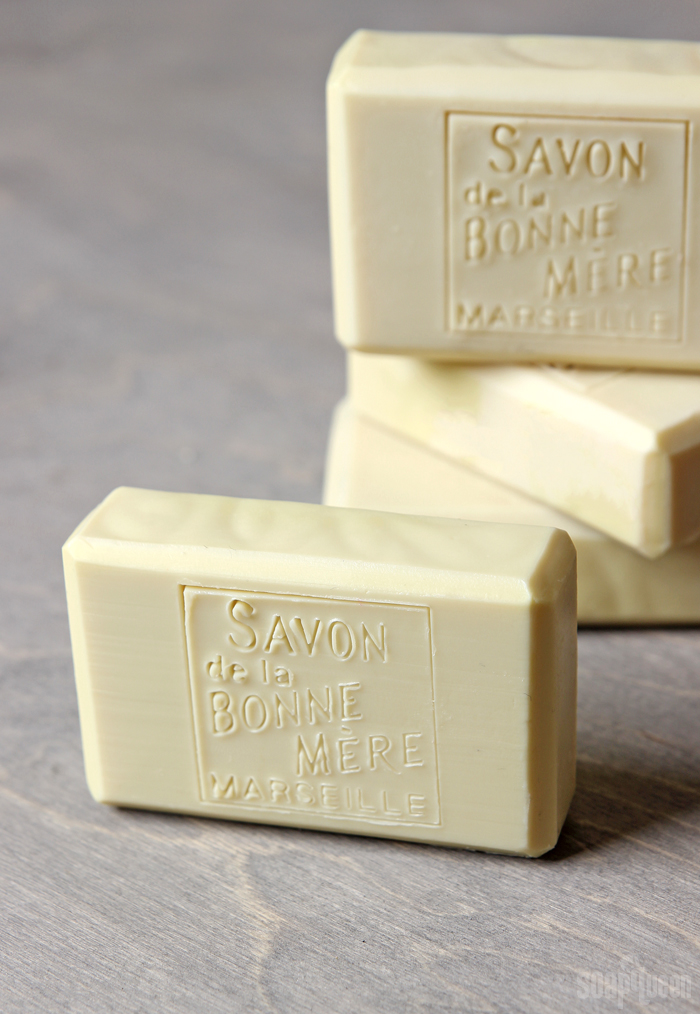
This soap is simple with no colorants or design elements. To give the soap a little interest, I stamped each bar with the Savon Soap Stamp. Savon de Marseille (aka: Marseille soap) is traditional soap made from vegetable oil and olive oil in Marseille, France. I thought it was very fitting for this recipe! For tips on stamping soap, check out this video. I scented this batch with Tomato Leaf Fragrance Oil, which is a wonderfully herby, green and fresh fragrance.
What You’ll Need:
10″ Silicone Loaf Mold
35 oz. Pure Olive Oil
4.5 oz. Sodium Hydroxide Lye
9.2 oz Distilled Water (20% water discount)
2 oz. Tomato Leaf Fragrance Oil
Savon Soap Stamp
Optional (but highly recommended!): Sodium Lactate

Click here to add everything you need for this project to your Bramble Berry shopping cart!
If you’ve never made Cold Process soap before, stop here! I highly recommend checking out our FREE four part SoapQueen.tv series on Cold Process Soapmaking, especially the episode on lye safety. And if you’d rather do some reading, Bramble Berry carries a wide range of books on the topic, including my newest book, Pure Soapmaking. You can also checkout the digital downloads for that instant gratification factor.
SAFETY FIRST: Suit up for safe handling practices! That means goggles, gloves and long sleeves. Make sure kids, pets, and other distractions and tripping hazards are out of the house or don’t have access to your soaping space. Always soap in a well-ventilated area.
FRAGRANCE PREP: Measure 2 ounces of Tomato Leaf Fragrance Oil into a glass, fragrance oil safe container. Set aside.
ONE: Slowly and carefully add the lye to the water and gently stir until the lye has fully dissolved and the liquid is clear. Set aside to cool. For this recipe, I highly recommend using sodium lactate. Sodium lactate will hep you remove the soap from the mold much faster. Use 1 teaspoon of sodium lactate per pound of oils in the recipe. For this recipe, you’d add about 2 teaspoons sodium lactate. Add the sodium lactate to the cooled lye water.
TWO: Pour the olive oil into your mixing bowl, and heat to 120-130 degrees. Once the lye water and the oils have both cooled to about 130 degrees (and are ideally within 10 degrees of each other), add the lye water to the oils and stick blend until you reach a light trace. This may take a little longer than usual, since this recipe is 100% olive oil!
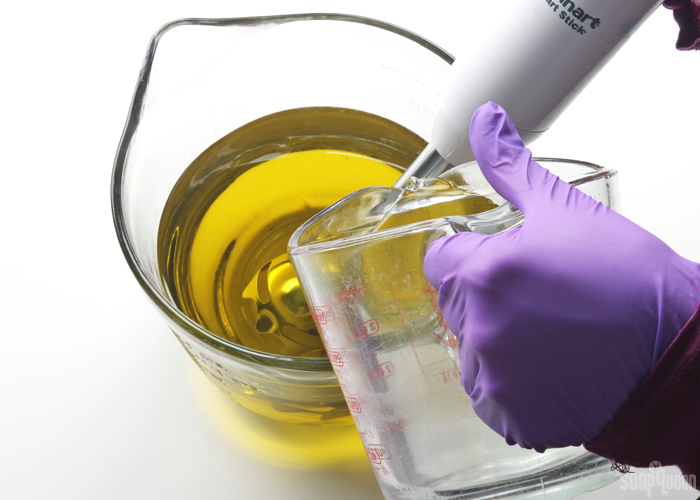
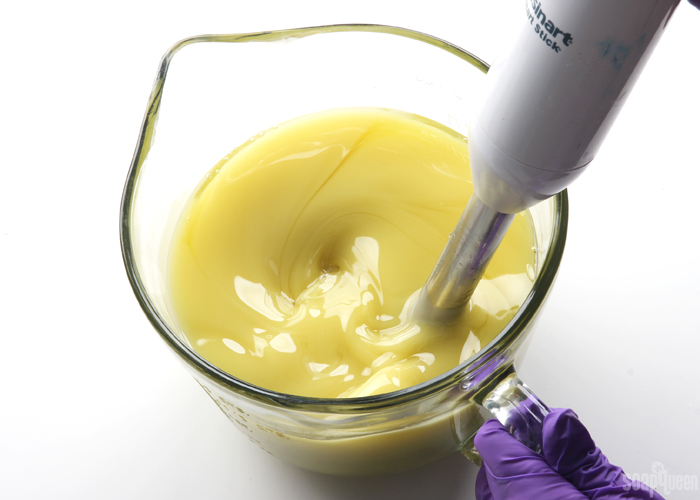 THREE: Add the Tomato Leaf Fragrance Oil and use the stick blender to mix in. Continue pulsing the stick blender and using it to stir until there is no longer streaks of fragrance oil. Don’t worry about over stick blending, this recipe gives you plenty of time to work with it!
THREE: Add the Tomato Leaf Fragrance Oil and use the stick blender to mix in. Continue pulsing the stick blender and using it to stir until there is no longer streaks of fragrance oil. Don’t worry about over stick blending, this recipe gives you plenty of time to work with it!
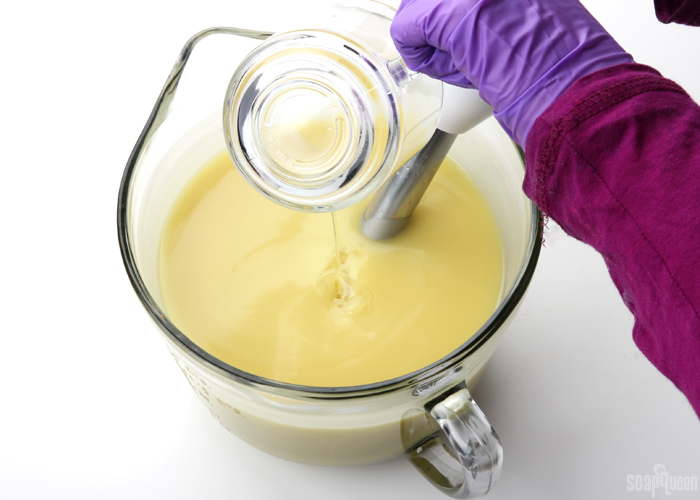 FOUR: Continue to stick blend until you reach a thin-medium trace. This can take several minutes. Pour the soap into the mold, and use a spoon or spatula to even out the top if necessary. Tap the mold on the counter to help get rid of any bubbles. Spritz the top with alcohol to help prevent soda ash. Cover the mold, and insulate the soap for 24 hours to help promote gel phase. Gel phase is not absolutely necessary, but it will help the soap unmold a little sooner!
FOUR: Continue to stick blend until you reach a thin-medium trace. This can take several minutes. Pour the soap into the mold, and use a spoon or spatula to even out the top if necessary. Tap the mold on the counter to help get rid of any bubbles. Spritz the top with alcohol to help prevent soda ash. Cover the mold, and insulate the soap for 24 hours to help promote gel phase. Gel phase is not absolutely necessary, but it will help the soap unmold a little sooner!
Once the mold can be pulled away from the sides of the soap with little resistance, carefully remove from the mold and cut into bars. With a 20% water discount, sodium lactate and gelling, I was able to unmold and cut this soap in 2 days. Without one or all of these methods, this soap can take up to 2 weeks to remove from the mold, so be patient. =)
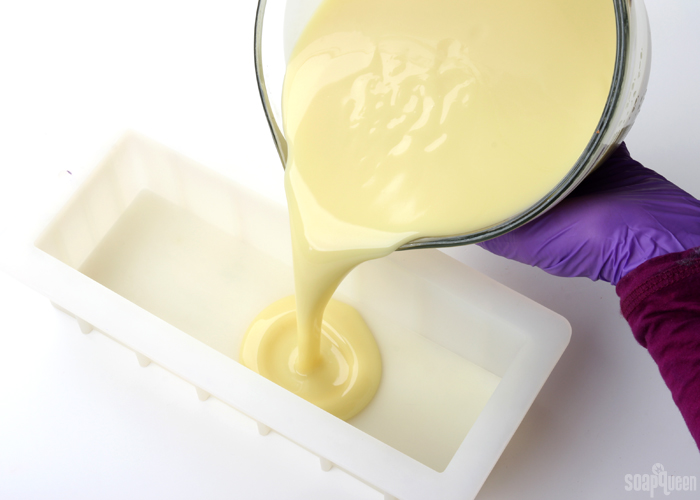 FIVE: Once the soap is cut into bars, use the Savon Soap Stamp to stamp the soap directly in the center. Check out this video for tips on stamping your soap. I found it was best to stamp these bars after right after unmolding. I also used the soap beveller to clean up the edges of these bars. Allow the bars to cure for 4-6 weeks, and enjoy! Some soapers prefer to allow Castile soap to cure for up to 6 months to a year! The longer the cure time, the more the lather will improve.
FIVE: Once the soap is cut into bars, use the Savon Soap Stamp to stamp the soap directly in the center. Check out this video for tips on stamping your soap. I found it was best to stamp these bars after right after unmolding. I also used the soap beveller to clean up the edges of these bars. Allow the bars to cure for 4-6 weeks, and enjoy! Some soapers prefer to allow Castile soap to cure for up to 6 months to a year! The longer the cure time, the more the lather will improve.
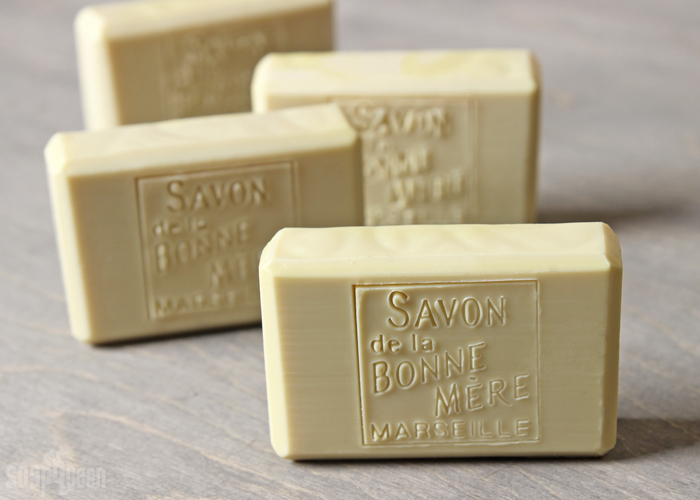
- 10″ Silicone Loaf Mold
- 35 oz. Olive Oil
- 4.5 oz. Sodium Hydroxide Lye
- 9.2 oz Distilled Water (20% water discount)
- 2 oz. Tomato Leaf Fragrance Oil
- Savon Soap Stamp
- Optional (but highly recommended!): Sodium Lactate
- Slowly and carefully add the lye to the water and gently stir until the lye has fully dissolved and the liquid is clear. Set aside to cool. For this recipe, I highly recommend using sodium lactate. Sodium lactate will hep you remove the soap from the mold much faster. Use 1 teaspoon of sodium lactate per pound of oils in the recipe. For this recipe, you’d add about 2 teaspoons sodium lactate. Add the sodium lactate to the cooled lye water.
- Pour the olive oil into your mixing bowl, and heat to 120-130 degrees. Once the lye water and the oils have both cooled to about 130 degrees or below (and are ideally within 10 degrees of each other), add the lye water to the oils and stick blend until you reach a light trace. This may take a little longer than usual, since this recipe is 100% olive oil!
- Add the Tomato Leaf Fragrance Oil and use the stick blender to mix in. Continue pulsing the stick blender, and using it to stir until there is no longer streaks of fragrance oil. Don’t worry about over stick blending, this recipe gives you plenty of time to work with it!
- Continue to stick blend until you reach a thin-medium trace. Pour the soap into the mold, and use a spoon or spatula to even out the top if necessary. Tap the mold on the counter to help get rid of any bubbles. Spritz the top with alcohol to help prevent soda ash. Cover the mold, and insulate the soap for 24 hours to help promote gel phase. Gel phase is not absolutely necessary, but it will help the soap unmold a little sooner! Once the mold can be pulled away from the sides of the soap with little resistance, carefully remove from the mold and cut into bars. With a 20% water discount, sodium lactate and gelling, I was able to unmold and cut this soap in 2 days. Without one, or all of these methods, this soap can take up to 2 weeks to remove from the mold, so be patient. =)
- Once the soap is cut into bars, use the Savon Soap Stamp to stamp the soap directly in the center. Check out this video for tips on stamping your soap. I found it was best to stamp these bars after right after unmolding. I also used the soap beveller to clean up the edges of these bars. Allow the bars to cure for 4-6 weeks, and enjoy!
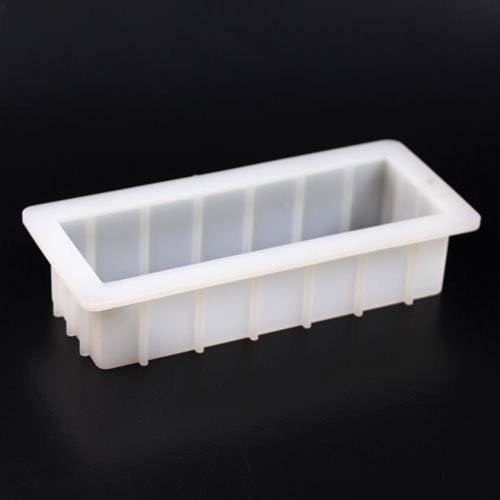
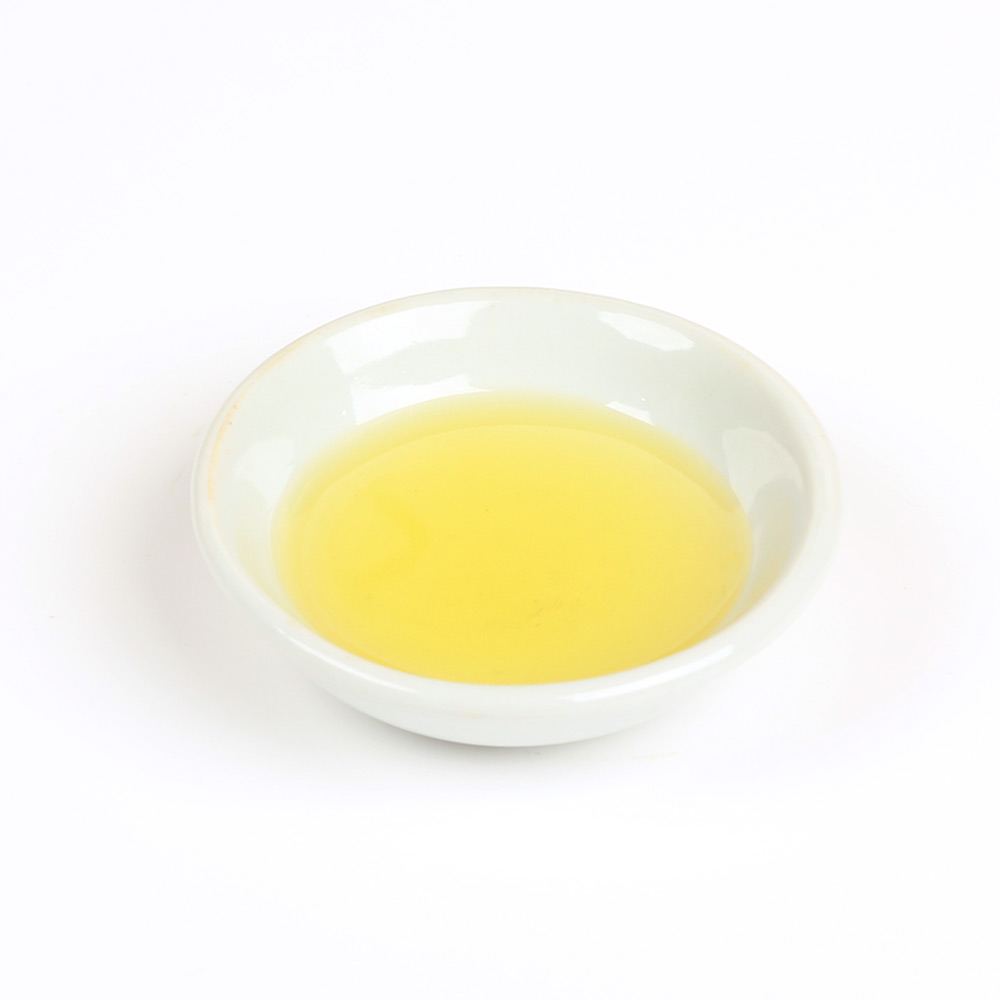
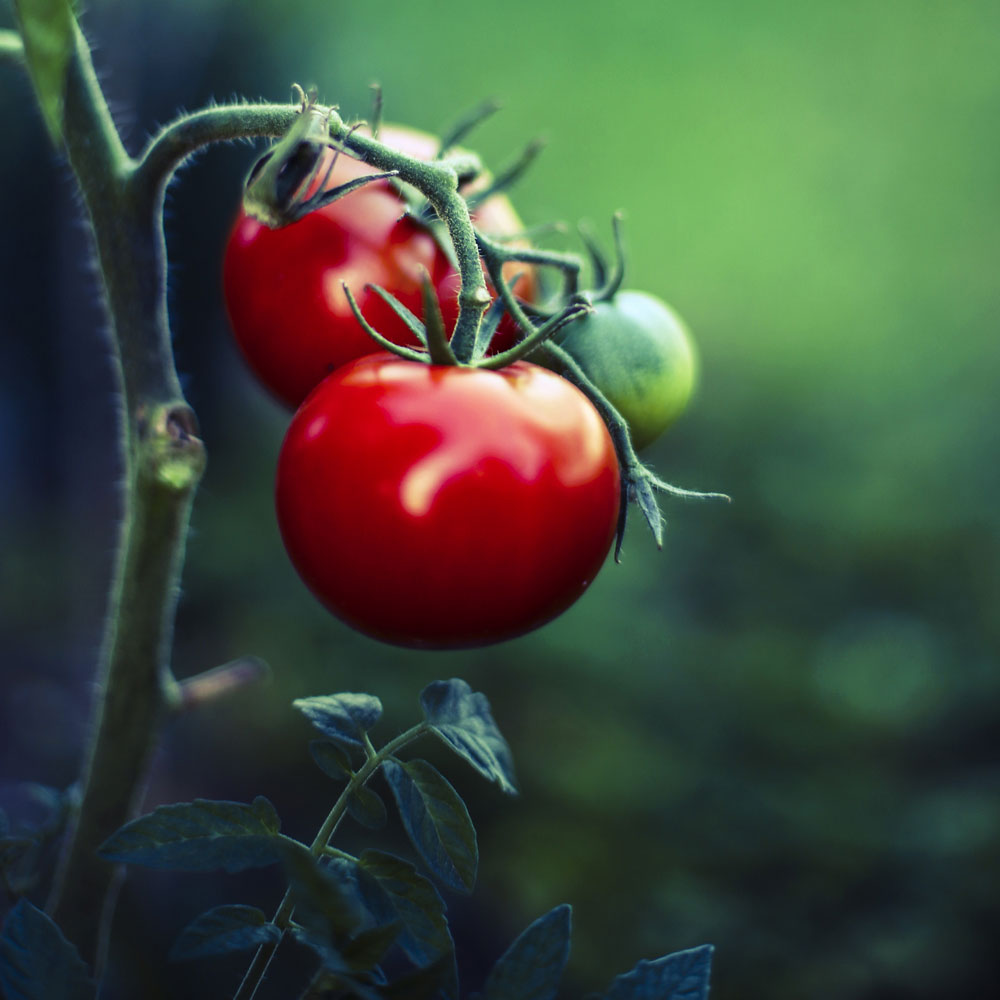
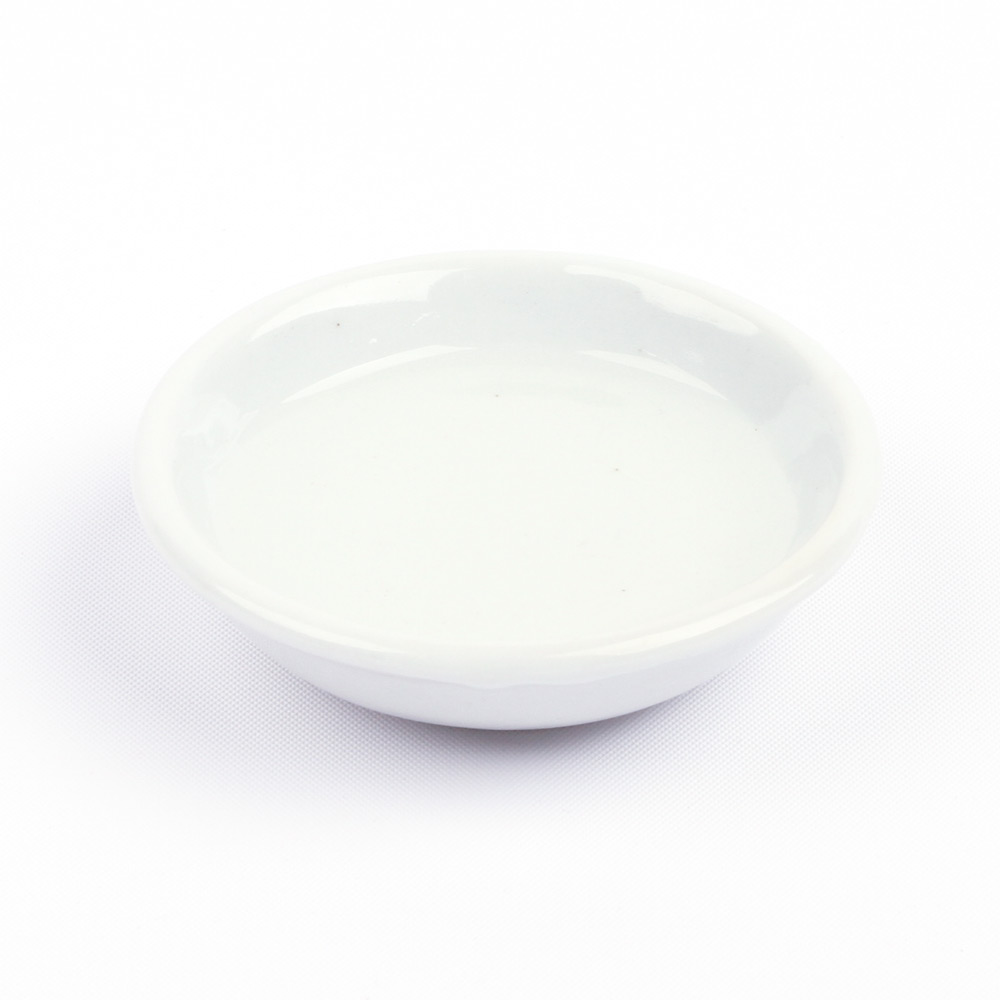
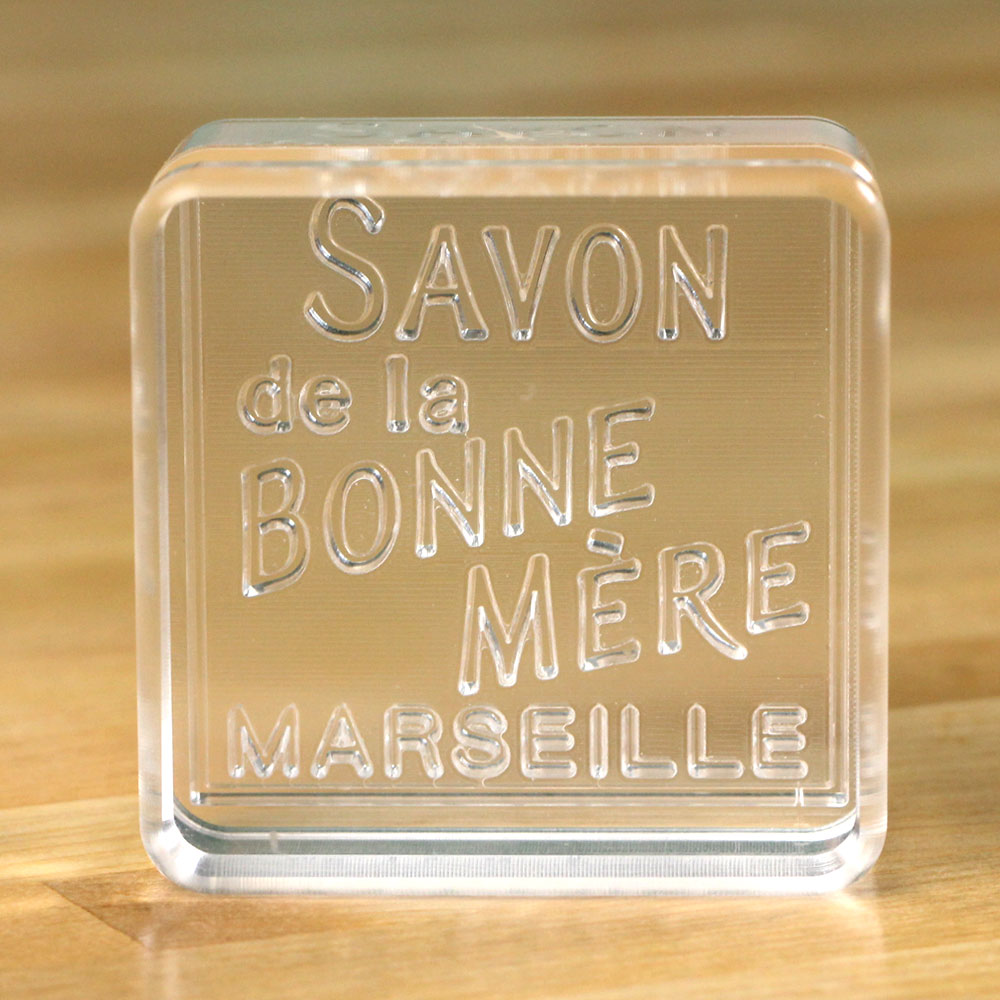
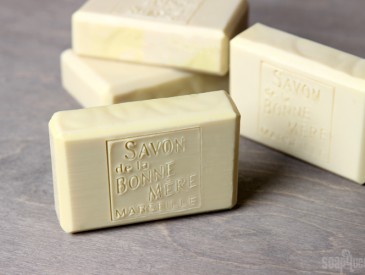



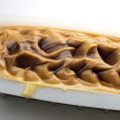

Newbie question here: Does the (20% water discount) in the formula mean it has already been calculated into the formula as a final 9.2 oz water? Or that 20% still needs to be subtracted from the 9.2 oz of water ?
Thanks!
It has already been removed from the recipe so you can make it as is!
Is there any way to make a Castile soap and using ACV instead of water??
No, we don’t recommend that. Vinegar reacts with the lye and may prevent the chemical reaction needed for the recipe to turn into soap. You’ll want to use distilled water.
What is the shelf life of a Castile soap? Assuming it is stored in a cool, dry environment and barring any odd reactions from additives?
Olive oil has a shelf life of about 2 years, so the soap will as well.
Learn more about the shelf life of products here: https://www.soapqueen.com/bath-and-body-tutorials/tips-and-tricks/shelf-life-bath-products-ingredients-rancidity-vs-mold/
So this was my first ever batch of cold process soap!! I followed the directions but after using the hand mixer for only a couple minutes it was already pretty thick so I put it in my molds and covered like you said do you think this will turn out or did I mess up somewhere???
Were you using a stick blender (immersion blender) or a handheld electric mixer?
Mam Castile soap melting fastly..What should I do?
That’s normal for Castile soap, which is very soft. Try curing the soap for 1-3 months. It makes it harder and last longer in the shower. Then, place it on a draining soap dish in a dry part of your shower.
Get more tips here: https://www.soapqueen.com/bath-and-body-tutorials/tips-and-tricks/make-soap-last-longer-shower/
I tried this today as my first CP soap and so far am loving the results! I omitted the sodium lactate and fragrance but kept everything else the same and found that I was able to unmold and cut the soap after about 12 hours. I was expecting to wait several days or a couple weeks and was pleasantly surprised.
I live at almost 6,000 ft above sea level and I noticed this affects M&P. (I have to pour at least 10 degrees hotter and I generally unmold in an hour or two.) Are there any blog articles or other resources about soaping at high altitudes? Specifically I’m wondering how this affects CP soaping temperatures, gel phase, water discount, and curing time. I suspect the elevation had a lot to do with the quick time to unmold but I can’t find any information on it.
We haven’t done testing in different altitudes, so I’m not entirely sure. It may affect how your soap performs – it helps to keep notes so you know what to expect as far as curing, the time it takes to unmold, etc.
We do know that temperature and humidity play a big role in soapmaking. Soaping at hotter temperatures and gelling the soap helps it unmold more quickly, as does a water discount. As far as curing, the bars do best in a cool, dry environment with plenty of airflow. I’ll link posts below that have more information about that.
When to Insulate Soap: http://www.soapqueen.com/bath-and-body-tutorials/tips-and-tricks/when-to-insulate-handmade-soap/
Water Discounting: http://www.soapqueen.com/bath-and-body-tutorials/tips-and-tricks/water-discounting-cold-process-soap-how-why/
How Temperature Affects Cold Process Soap: https://www.soapqueen.com/bath-and-body-tutorials/tips-and-tricks/back-to-basics-how-temperature-affects-cold-process-soap/
How to Store Handmade Bath Products: http://www.soapqueen.com/bath-and-body-tutorials/tips-and-tricks/how-to-store-handmade-bath-products/
Thank you so much!
Hi
Soaping newb here. When I run this through the lye calc on brambleberry, I am getting a lower lye amount. Am I doing something wrong?
What lye amount are you getting? I just checked and I got 4.5 oz.
The recipe above calls for 4.60 oz.
Thanks for catching that Liz! It looks like this may have been formulated with a slightly lower superfat amount than our normal 5%. To keep things consistent, we updated the post to reflect a 5% superfat, which is 4.5 oz of lye.
I made this today and to my surprise the soap is a beautiful almost white and I could unmold in 5 hours time…
Did you add anything to the recipe, like salt? Or did you change any of the measurements? The soap should take at least 2 days to harden.
Made this soap for the first time the other day. Very easy to follow instructions. It’s absolutely beautiful – very light cream color. I color all my soaps, so this was a first for me. I don’t know if I’ll be able to wait the full 6 mo. to let it cure. Maybe if I hide it, I’ll forget about it. But with my luck, I’ll probably forget where I hid it. 🙂 I make a LOT of Anne-Marie’s recipes and they’re absolutely flawless. I’m not into creativity, as much as I am about getting great results for my effort. A win every time! Thank you.
I made this soap today. I added some sodium lactate to help it set. Because your write up talks about it taking up to two weeks to unmold, I left the silicone mold at the beach. I will be back there in 5 days. Now I’ve read many of the comments stating they were able to unmold in 24-48hrs. Will my soap be ok in 5 days. Oh I didn’t wrap it in a towel.
Yes, your soap will be just fine. The extra days there will help it harden so it unmolds more easily. If you find it’s still pretty soft to the touch when you get back, let it sit a few more days. If it’s firm, it’s ready to cut and cure.
Hi there! I have one question about this recipe. When it talks about gelling in step four, it says we insulate to prevent gelling. Doesn’t insulating promote gelling? Thanks! I am looking forward to making this recipe tomorrow with a couple little changes and am excited to see the result!
Yes, we will get that typo fixed. Thank you.
Hi, I am a big fan of your soap! Thanks so much for tutorials. I have some question about Olive oil soap. I made it a few time (from your recipe). And I have no problem removed it out of the mold. And I wait less than 24 hours. Is this normal? Also, I am wondering if we can color this recipe or make it layered? And one more question, what would happen if we use soap before the cure time. Like within 3 weeks? Would it harm to the body? Thank you so much again!!
That’s great if it can be removed early. If you find it’s firm after 24 hours, go ahead and take it out of the mold, cut it, and start the curing process. Technically the soap is safe to use after 3 weeks, but we recommend curing at least 6 weeks for the best results. That allows any excess water to evaporate, which creates harder bars that last longer in the shower.
You can definitely color and layer the soap. Find tips on how to color soap here: http://www.soapqueen.com/bath-and-body-tutorials/tips-and-tricks/talk-it-out-tuesday-colorants/
And find layered designs for inspiration here: https://www.soapqueen.com/category/bath-and-body-tutorials/cold-process-soap/
Thank you so much!!
Hi,
I followed your recipe exactly and was able to easily remove my soap from the mold in two days. I immediately used the stamp but the impressions aren’t as clean as yours. Some of the soap stuck in the mold and I wonder if that is typical or if my soap isn’t hard enough to stamp yet? This was my first time stamping so I’m not sure what to expect. Thanks so much!
I meant, some of the soap stuck in the stamp…not the mold. 😀
I’m thinking the soap may be a bit too soft. I would recommend waiting another day or two and trying again. It also helps to give it a few good whacks with a mallet or another tool to leave a good impression. If it’s too gentle, it can take some of your soap with it. See that process here: https://www.youtube.com/watch?v=2YBdHHQURKk&t=6s
-Kelsey with Bramble Berry
Thank you!
I’ve made a few batches of soap before, a few years back. Today I tried this recipe for a medieval demonstration, whisking by hand. After two hours id whisking it did not come to trace, but it seemed emulsified so I poured it into the mold anyway. I spritzed the top with isopropyl alcohol to prevent soda ash. An hour or so later, I noticed it had these white flecks on top (http://i.imgur.com/xIyxKXI.jpg). My first thought was a reaction with an essential oil that was too old/incompatible; I did not use my BrambleBerry tested oils for this batch unfortunately. Or could it be soda ash?
Also, I didn’t add the essential oil until I decided to give up and pour it into the mold, so I know it didn’t impact coming to trace. My oil was room temperature and my lye water was still a bit hot. I did not use the sodium lactate. Would it have come to trace had I kept whisking? I know that olive oil soap takes longer to come to trace, but two hours seemed like plenty of time.
What does that soap look like now – do you notice any white specks or pools of oil? Did you use hard oils or butters in your batch, like coconut or shea?
-Kelsey with Bramble Berry
I believe it was just soda ash. My oils and possibly my lye were at room temperature which I know increases the chance of soda ash forming. I made the same mistake soaping at such low temperatures again with the same results which made me realize! It was 100% olive oil soap.
That makes sense, lower temperatures do increase the chances of soda ash. You can increase those temperatures, or try a water discount. That really helps: http://www.soapqueen.com/bath-and-body-tutorials/tips-and-tricks/water-discounting-cold-process-soap-how-why/
Explaining and Preventing Soda Ash: http://www.soapqueen.com/bath-and-body-tutorials/tips-and-tricks/explaining-and-preventing-soda-ash/
I am new to soap making but I am very interested in making Castille soap.
My question: if we were to add salt to this recipe instead of sodium lactate (because it is a salt in a way) what would be the difference/performance?
I looked at your salt bar recipes (in search of “hard bar” solutions without the use of palm oil) and it seems that salt may be fairly as efficient as sodium lactate, but it is?
Thank you!
Are you wanting to add straight salt to the soap, or use a salt water solution that acts like the sodium lactate? You can also make a brine soap, which has salt water mixed with lye.
-Kelsey with Bramble Berry
Also, isn’t there a similar recipe for liquid castile soap using olive oil and potassium hydroxide? Im thinking that would work better if one wanted to use this soap for shampoo.
We have a liquid soap kit that has olive and coconut oil. It feels really nice on the skin. Find that kit here: https://www.brambleberry.com/Liquid-Soap-Guru-Kit-P4829.aspx
We also have premade Castile soap bases you may like: https://www.brambleberry.com/Liquid-Bases-C15.aspx
-Kelsey with Bramble Berry
Hello, are the measurements in this recipe weight or volume ounces? Thanks!
These measurements are by weight. So, pop a container on the scale, zero it out, and measure your ingredients that way.
-Kelsey with Bramble Berry
Hello!
I made Castile soap a couple of days ago. It was easy to unmold but the soap was broken to pieces when I cut it. May I know the reason? My recipe is, pure olive oil 312g, water 103g, 1 teaspoon of salt, Lye 40g.
I’m thinking it may be the salt. How did you add it, and when did you cut the soap?
-Kelsey with Bramble Berry
I added the salt into water and then added lye when salt was melted. I kept the soap in mold 2 days and cut.
Thanks so much, I think it is the salt. Salt hardens the soap really quickly, and if it’s not cut soon enough it can crumble. It helps to cut your bars as soon as they’re firm, which can happen in the first few hours. Check that soap after about an hour – if it’s firm to the touch you can cut it. Make sure to wear gloves.
-Kelsey with Bramble Berry
Hello! Can you tell me the recommended superfat percentage for castile soap?
Thank you!
We superfatted this soap at 5%. We find that adds a bit of luxury without making it too soft. You can do any level you like though! A lower level will make the bars a bit more firm, and a higher level will add more freefloating oils. Learn more about superfat here: http://www.soapqueen.com/bath-and-body-tutorials/cold-process-soap/superfatting-soap-an-explanation-2/
-Kelsey with Bramble Berry
Hi again!
If I wanted to add castor oil to this recipe, to add lather, would I just subtract the amount of olive oil? For instance, add 3 ounces of castor oil and use only 32 oz of olive oil? I am fairly new at cold process, and this whole percentage thing makes me crazy!!!! And, how much castor oil would you recommend for a nice lather???? In ounces?
Thank you so much. I’d like to make this today if possible.
A nice percentage of castor oil is right around 3%! For this recipe, that is 1 ounce. I found that using our Lye Calculator! I selected “Percentage” then plugged in the oil weight, which is 35 ounces. From there, you can input 97% olive oil and 3% castor oil. 🙂
Lye Calculator: https://www.brambleberry.com/Pages/Lye-Calculator.aspx
-Kelsey with Bramble Berry
Thank you
Rather than using a stamp, I was thinking about using an impression mat on the bottom of this mold. Not using separate colors or anything. What do you think? I’m fairly new at soap making, and have done cold process before, just a little cautious before whipping up whole batches and trying new things without someone else’s input. Thank you.
That would look really lovely! Impression mats are a fun way to get an interesting pattern on top of your soap. See how to work with those in this video: https://www.youtube.com/watch?v=lypXN_7aB3A
And find our impression mats here: https://www.brambleberry.com/Search.aspx?k=impression+mat
-Kelsey with Bramble Berry
Hi! First of all I would like to say thank you because I’ve been learning from your videos and blog since a quite long tima ago.
I wanted to make this soap, but instead of sodium lactate, i’ve got Stearic acid, which I was told was good and suitable to make Castile Soap, in order to harden the bar, together with a couple of spoons of vegetal glicerin. Do you think I’m proceeding Ok? If so, could you tell me when do I have to add these two ingredients?. Thank you very much in advance. Best regards from Spain.
P.S.: You should consider the idea of opening a franchise in Europe-Spain 😀
Lots of love,
Alexandra.
Thank you, so glad you’re enjoying the blog and videos! You can use stearic acid at .5% of your oil weight to harden the bars. Because stearic acid has a high melting point, you’ll need to soap around 160-170F so it stays melted the whole time. It will also accelerate trace, so be prepared to move quickly!
Stearic acid: https://www.brambleberry.com/Stearic-Acid-by-weight-P4210.aspx
As for the glycerin, I wouldn’t recommend it. Soap produces glycerin naturally. Adding more can cause glycerin rivers: https://www.soapqueen.com/bath-and-body-tutorials/tips-and-tricks/river-runs-deep-explanation-glycerin-rivers/
-Kelsey with Bramble Berry
Thank you so so much.
Big hug for all of you.
:*
Alex.
I am looking at this recipe and another Castile recipe from “Pure Soapmaking” by Anne-Marie (yay!) and I’m curious about using sea salt AND sodium lactate.
Her recipe calls for the addition of sea salt, but this one calls for sodium lactate. Can I use both in a Castile recipe to make a harder bar? What would that do?
We haven’t given that a try, so I’m not entirely sure. I think it would be OK! It should help the bars harden fairly quickly. You may want to make a small test batch just to be sure though. 🙂
-Kelsey with Bramble Berry
Hello, I made a Castille soap a month ago and is really hard but it has created a strange white powder around the soap, not sure if is soda ash, never seen soda ash that heavy that you can brush it off, I stemed it and it looks a little better, also I used it and it seems ok. When you start using it the powder goes away but it doesn’t ladder much.
Thank you in advance for your response
Yeni
That sounds like soda ash! Soda ash can be just on the surface, but it can also run all the way through the bar and sometimes even create a crumbly feeling. The good news is the bar is just fine to use! Learn more about how to prevent soda ash here: http://www.soapqueen.com/bath-and-body-tutorials/tips-and-tricks/explaining-and-preventing-soda-ash/
As for the lather, Castile bars aren’t as bubbly. They’re known for being moisturizing and gentle on the skin but won’t have as much lather as other recipes. You can add more lather if you like! Using castor oil at 2-5% really helps. You can also add honey, which helps add lather. 🙂
Learn more about castor oil here: https://www.soapqueen.com/bath-and-body-tutorials/tips-and-tricks/sunday-night-spotlight-castor-oil/
And more about using honey here: https://www.soapqueen.com/bath-and-body-tutorials/tips-and-tricks/use-honey-bath-beauty-products/
-Kelsey with Bramble Berry
I was just wondering if I could use extra virgin olive oil from my health food store here at the same quantities as this recipe calls for which leads into my question of whether or not different olive oil brands affect lye differently. The same question holds true of the lye. We have it at the hardware store here. I’ve read comments that you should always put the ingredients though the lye calculator before making soap but I don’t see anywhere on your calculator to put in specific brands of or specifications of lye or oils.
Hi Michele!
That’s a great question! We were curious as well, so we tested several store bought brands of olive oil. We found that even though most olive oils had longer shelf lives on the bottle, they tended to go rancid fairly quickly when used in soap. That’s because they are sitting on shelves for long periods of time before being bought. The best place to get store bought olive oil is at a large store like Costco or Sam’s Club. Because they have really high turnover, the olive oil is more fresh.
Read more about our experiment here: https://www.soapqueen.com/bath-and-body-tutorials/tips-and-tricks/olive-oils-created-equally/
Different brands of oil can have different SAP values. However, our Lye Calculator accounts for small differences and you can plug in your oil. Also, if there is any discrepancy, the superfat level will cover it. Along with adding luxury to your bars, it acts as insurance for any small miscalculations. 🙂
Lye Calculator: https://www.brambleberry.com/Pages/Lye-Calculator.aspx
Read more about superfat here: http://www.soapqueen.com/bath-and-body-tutorials/cold-process-soap/superfatting-soap-an-explanation-2/
-Kelsey with Bramble Berry
I am trying to come up with a soap recipe that has more olive oil than any other oil, because it is so good for sensitive skin. My question is: Does Olive Oil in a soap recipe either 72% or 100% make a nice hard bar of soap that will last a while in the shower? If theres anything I hate its a soft bar of soap that doesn’t last. Thank You! 🙂
Hi Amanda!
Castile soap is a fairly soft bar of soap. You can use a water discount like we did in this tutorial to harden it up faster and cure it at least 4-6 weeks to make it last longer, but overall it will be softer. If you prefer a hard bar, I would recommend using hard oils like coconut and palm at 33%. A great classic recipe is 33% coconut, 33% palm and 33% olive. That gives you a firm bar that’s still moisturizing because of the olive oil. 🙂
Read more about formulating cold process recipes here: http://www.soapqueen.com/bath-and-body-tutorials/tips-and-tricks/formulating-cold-process-recipes/
-Kelsey with Bramble Berry
Coconut oil: https://www.brambleberry.com/Coconut-Oil-P3196.aspx
Palm oil: https://www.brambleberry.com/Palm-Oil-P3210.aspx
Hi,
If i want to use any other essential oil like lemon instead of tomato leaf fragrance, how much amount should i use for this recipe?
Thanks
Hi there! You can use our Fragrance Calculator to find out exactly how much to add! It gives you a light, medium and strong recommendation. 🙂
Fragrance Calculator: https://www.brambleberry.com/Pages/Fragrance-Calculator.aspx
-Kelsey with Bramble Berry
Is it possible to use a small percentage of another oil like coconut or jojoba to help it cure faster? I was hoping to have these bars ready for Christmas (10~ weeks) as gifts and I’m not sure about the availability of Sodium Lactate in my country (hard to find or very expensive online, I’m not sure which brick and mortar stores would carry it. Food supply stores?). Or would gelling and the water discount be enough? I could always use a different recipe that has a shorter curing time, but I already have the ingredients for this (minus the Sodium Lactate) including the coconut oil. I’m a beginner too so I figured the simpler the better.
Hi Ginger!
You can add a hard oil like coconut, palm or cocoa butter! That plus a water discount will help this soap harden and cure faster. Coconut oil also adds lathering and cleansing properties to the mix. 🙂
Learn more about hard oils like coconut and how much to add to your recipe here: http://www.soapqueen.com/bath-and-body-tutorials/tips-and-tricks/free-beginners-guide-to-soapmaking-common-soapmaking-oils/
-Kelsey with Bramble Berry
Hi so I see everyone uses a stick blender, I’m assuming that’s because of splash back. Can you use a normal hand beater? Also I’m trying to find a large mixing pot to handle larger batched for 7lbs mold size. Can I use a metal turkey roasting pan to mix in?
Thanks for the reply!
Just to double check if I’ve got this right (if I want 15% Coconut Oil): that would be 15% of the Olive Oil at 5 oz. I should take that 5 oz out of the Olive Oil leaving it at 30 oz right? I won’t forget to put it back through the lye calculator to adjust for the different oil!
Hi Sandy!
We definitely recommend a stick blender for cold process soaping. Hand blenders will emulsify the soap, but it can take at least two hours. Stick blenders emulsify the soap in just a minute or two. They’re so nice to have!
Also, you can mix the soap in the roasting pan as long as it’s stainless steel. Lye reacts with aluminum and can create toxic fumes, so stainless steel is best. You can also use glass or heat-resistant plastic. 🙂
Learn more about soaping tools in this post: https://www.soapqueen.com/bath-and-body-tutorials/tips-and-tricks/soapy-session-setup-guide/
-Kelsey with Bramble Berry
Hi Ginger!
That is correct! The 5 ounces of coconut oil is about 14% and the olive oil is about 86%. That will add some nice cleansing and firming properties to these bars. 🙂
-Kelsey with Bramble Berry
Lye Calculator: https://www.brambleberry.com/Pages/Lye-Calculator.aspx
I have a question regarding lye purity and your lye calculator. I purchased lye from bulk apathacary and they say their sodium hydroxide is pure, but your calc says it assumes 97% purity. How would you compensate for the difference?
Hi Kallie!
Our lye is 98% pure, with the other 2% being an anti-caking agent. It doesn’t affect the soaping process at all! You can use the lye as is without having to add anything extra. 🙂
Sodium Hydroxide Lye: https://www.brambleberry.com/Sodium-Hydroxide-Lye-P3037.aspx
Lye Calculator: https://www.brambleberry.com/Pages/Lye-Calculator.aspx
-Kelsey with Bramble Berry
Thanks so much for your help. I wanted to make sure I was calculating my recipes correct. 🙂
You’re welcome! 🙂
Hi Kelsey,
I’ve never made a soap before but I would like to try this recipe for my first go. Unfortunately I cannot get the Tomato leaf fragrance. What fragrance or essential oil could I substitute this with? I have Lavender and Sweet orange essential oils at home – how much would I need to use of those in comparison with fragrance? Thanks!
You can use lavender or sweet orange in this recipe! They will smell fantastic. You can also mix them for a citrusy, herby scent blend. 🙂
The usage rates for essential oils are a bit different than fragrance oils. Find out how much to add to your recipe with our Fragrance Calculator: https://www.brambleberry.com/Pages/Fragrance-Calculator.aspx
This post on how to blend essential oils is helpful too: https://www.soapqueen.com/bath-and-body-tutorials/tips-and-tricks/how-to-blend-essential-oils-safely/
-Kelsey with Bramble Berry
Kelsey-Could I replace the water with goat’s milk in this recipe? i.e. Goat’s Milk Castile Soap 🙂
Absolutely! That will add a really nice creamy feeling to the soap. 🙂
With milk, I would definitely recommend discounting. It has extra fat that can make the soap softer. Discounting at least 15-20% is a good place to start! Read more about water discounting here: http://www.soapqueen.com/bath-and-body-tutorials/tips-and-tricks/water-discounting-cold-process-soap-how-why/
We also recommend freezing the milk before adding the lye to prevent it from scorching. That helps prevent discoloration in the soap. Learn more about working with milk here: http://www.soapqueen.com/bath-and-body-tutorials/tips-and-tricks/how-to-add-lye-to-milk-for-cold-process-soap/
-Kelsey with Bramble Berry
Hi,
I too would like to use goats milk soap. I am pretty new to this and I read the discounting page but didn’t quite get it. Could you explain a little. Also could this be done hot process method? I would like to give these as gifts soon.
If so would I still use sodium lactate in hot process? Any guidance would be much appreciated. Thanks!
also can I use a stamp on hot process soap? If so when. Thanks again
Hi Kris! I can definitely help you out. What would you like to know about water discounting? Also, if you’re using milk, hot processing the soap can be tricky. When milk gets hot it scorches, which causes discoloration and an unpleasant smell. Because you’re cooking the soap at 160F for a long time, the milk will most likely scorch. If you don’t mind that discoloration you can hot process. Also, the smell will fade as the soap cures. 🙂
Learn more about working with milk here: http://www.soapqueen.com/bath-and-body-tutorials/tips-and-tricks/how-to-add-lye-to-milk-for-cold-process-soap/
As for sodium lactate, we still recommend it! It helps make hot process soap soft and fluid. Learn more about hot processing soap here: https://www.youtube.com/watch?v=mxTXwxbpzLM&t=126s
As for stamping, you’ll want to do that as soon as the soap is cut. Hot process hardens quickly, so doing it earlier will make the process easier. 🙂
-Kelsey with Bramble Berry
We made this on Monday and it’s simply PERFECT!!! A simple, elegant pure soap! My father had a huge garden that was his pride. People would stop and look and his smile was a mile wide. He’s been gone for 13 yrs and the smell of tomato leaves always makes me smile. I love this recipe. My dad would have too. Thanks for this one for a million reasons. ❤️
Oh that’s amazing Liz, I’m so glad you’re loving this soap! I love how scent can trigger happy memories. You’ll think of your father every time you use it! 🙂
-Kelsey with Bramble Berry
I have a question. Can this recipe, with the water discount, be made in a crock pot to force it through gell phase quicker?
Absolutely! This recipe would work really well with the hot process method. That would allow you to unmold it even earlier – in just a day or so. 🙂
Learn more about hot process soap here: https://www.youtube.com/watch?v=mxTXwxbpzLM
-Kelsey with Bramble Berry
Made this recipe last night and it’s super hard less than 24 hours later – it’s nice and white and pulling away from the mold already. Great directions on how to promote gel phase, that made all the difference. For comparison, I had a little bit of extra soap batter which I poured into a small guest soap silicon mold and did not cover/wrap/insulate for gel phase and those are really soft and squishy today. I didn’t add any fragrance oil, and think I’m going to sell these as simple castile soaps. Thanks for the recipe and tips!
You’re welcome Katie! So glad the soap unmolded early – I love when that happens. Enjoy, it feels so awesome on the skin. 🙂
-Kelsey with Bramble Berry
I made this soap adding lavender oil great scent.The only problem was that after about 3 weeks it started going brown at the edges ,why is that?
Hmm, I’m not entirely sure why that is! Does the soap have an unpleasant smell at all – sort of like Playdough? Did you use any herbs/colors in the mix?
-Kelsey with Bramble Berry
No it smells great and I only used lavender essential oil.I put it uncovered in a draw and we do live in a warm climate(34C)
Do you have a picture of the soap? That would be really helpful! You can share that on our Facebook page: https://www.facebook.com/BrambleBerry/
-Kelsey with Bramble Berry
I made the “Quick & Easy Castile Soap” Recipe (https://www.soapqueen.com/bramble-berry-news/olive-oil/#more-39375) and it cured and hardened pretty fast. Came out of the silicone mold easily too. I used it after 6 weeks. Maybe it was the sodium lactate. I don’t know if I did something wrong or right but I do like the quick results.
Oh that’s awesome, glad to hear the soap was ready to use soon! Making it in individual cavity molds can help speed up the unmolding and curing process. 🙂
9 Cube Soap Silicone Mold: https://www.brambleberry.com/9-Cube-Soap-Silicone-Mold-P5229.aspx
-Kelsey with Bramble Berry
Is there a difference between olive oil extra virgin and pure as far as for CP soap making? If so, what are the differences in soaping? THX
Those two oils will feel very similar in soap! From what I understand, virgin olive oil is made from slightly riper olives. I’ve personally tried both and can’t tell a huge difference. You can definitely substitute extra virgin olive oil in this recipe if you like. 🙂
-Kelsey with Bramble Berry
Wondering if the bars come out NaHCO₃? It is really hard to make lye water and oil mix evenly. I did one on 30th Jan with honey, it is still good now, without NaHCO₃, and even it is during wet weather, it is very hard.
I’m not entirely sure what you’re asking Joyce, I’m sorry about that. Are you wanting to add sodium bicarbonate to this recipe?
-Kelsey with Bramble Berry
Hi Kelsey, I am also sorry that you can not get me. I do not know why it will get hard faster to add sodium lactate. Does it have response with lye water? If so, it will help to get trace soon and low the pH. As my experience, it is also not good to get trace soon. Effective collision is most important, so I control the temperature below to 30 degree to get more time to stir.
Oh wow I just made my first Castille soap last week for my little niece and nephew! I did 20% water discount also, added some coconut milk, sodium lactate, and CPOP! I left it unscented and color free because they were for kids. I was able to unmold the soap <48 hours! Hopefully it'll be ready in 3 months? Lol!
The water discount, sodium lactate and CPOP will speed up that cure time for sure! I would recommend letting it cure for 6 weeks and then testing a bar. If it’s still fairly soft, let it sit another couple weeks. I think your niece and nephew will really enjoy the soap! 🙂
-Kelsey with Bramble Berry
Is this soap good to go after a 4 to 6 week Cure? I thought Castille soap had to cure up to 6 months. Does the water discount make it have a normal cure time?
Hi Michael, I made a batch about 6 months ago. I used pomace olive oil, and 1:1 lye water. It worked beautifully, and I covered to gel. Well, when I went to check on it after 18 hours, I could not even cut it, it was that hard. I had to use a knife, and it was so hard that it was crumbling around the edges. Anyway, I’ve been testing a bar from time to time, and it’s still slimy lathered. So even a huge water reduction doesn’t help with the cure, I believe. I will leave it for a year or two, even longer. It’s a beautiful creamy white color now.
Thanks Martina – I have made castille soap one time before and i didn’t have any problems with unmolding or cutting it. But I let it sit and cure for almost 10 months. It did have a nice creamy vs. bubbly lather but it didn’t particularly seem any harder than any other soap I’ve made. Maybe longer cure would harden it up more.
The water discount helps cut down on cure time! I would recommend letting it cure 6 weeks, then checking a bar. If it’s still fairly soft, let it cure for another couple of weeks. You can also increase the discount to 30% or so to speed up cure time even more. 🙂
-Kelsey with Bramble Berry
I usually add a pinch of tussah silk to each batch of CP soap I make. Would you recommend doing this with Castile soap?
You can if you like! Castile soap naturally has a gentle, creamy feeling. The Tussah silk will add a bit of silkiness as well. 🙂
Sunday Night Spotlight: Silk: https://www.soapqueen.com/bramble-berry-news/sunday-night-spotlight-liquid-silk-tussah-silk-fibers/
-Kelsey with Bramble Berry
Would it be ok to use Pomace Olive Oil instead of Pure Olive Oil?
Thanks
You can! Olive oil pure and pomace feel similar in soap. The main difference is pomace thickens a little quicker and makes a slightly firmer bar. 🙂
Olive oil pomace: https://www.brambleberry.com/Olive-Oil-Pomace-P4928.aspx
-Kelsey with Bramble Berry
Thanks
I have a lot of Pomace oil and want to use it. Will be ordering the Pure Olive oil tomorrow.
Thanks
Thanks a bunch for your order Debra! 🙂
-Kelsey with Bramble Berry
Are you aware that in your instructions you say you are wanting to prevent gel phase?
Thanks for the typo catch! We meant to say “promote” rather than “prevent.” Very different outcomes! 😉
-Amanda with Bramble Berry
Why did you do a water discount, just curious and a newbie.
She mentioned in the first paragraph that the water discount was to help the soap to harden faster.
Cheryl is correct – the water discount helps the soap harden and cure faster! That’s because there is less water that needs to evaporate. It’s perfect for Castile soap, which can take longer to harden than a soap made with hard oils like coconut and palm. 🙂
-Kelsey with Bramble Berry